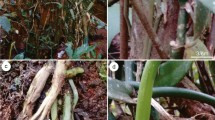Abstract
The great majority of angiosperm species form a group in which either every cell in the root epidermis produces a root hair, or the cells that produce these hairs are randomly distributed. We describe, for the first time, pattern in the root epidermal cells of a species within this group. The seedling root of Echium plantagineum L. (Boraginaceae) has an epidermis in which almost every cell produces a root hair, but these are of two types, short hairs (up to 200 μm) and long hairs (>200 μm), which are in separate cell files, with the cells bearing long hairs usually separated by one or two files of cells bearing short hairs; the epidermal cells with the long root hairs are longer than the epidermal cells with the short root hairs. The long root hairs are initiated and develop earlier than the short root hairs. Transverse sections of the region of the root which contains only developing long root hairs show that the hair cells are located above anticlinal walls between underlying cortical cells. We regard the distribution of root epidermal cells in E. plantagineum as a sub-type of this group. We discuss the possible evolution, from this sub-type, of another group that is characterised by hair cells and non-hair cells occurring in separate files.






Similar content being viewed by others
Abbreviations
- cryo-FESEM:
-
cryo-field emission scanning electron microscopy
- RHEZ:
-
root-hair emergence zone
- RHElZ:
-
root-hair elongation zone
- RHMZ:
-
root-hair mature zone
References
Angiosperm Phylogeny Group (1998) An ordinal classification for the families of flowering plants. Ann Mo Bot Gard 85:531–553
Bünning E (1951) Über die Differenzierungsvorgänge in der Cruciferenwurzel. Planta 39:126–153
Caradus JR (1980) Distinguishing between grass and legume species for efficiency of phosphorus use. N Z J Agric Res 23:75–81
Carol RJ, Dolan L (2002) Building a hair: tip growth in Arabidopsis thaliana root hairs. Philos Trans R Soc Lond Ser B 357:815–821
Clowes FAL (2000) Pattern in root meristem development in angiosperms. New Phytol 146:83–94
Cormack RGH (1935) Investigations on the development of root hairs. New Phytol 34:30–54
Cormack RGH (1945) Cell elongation and the development of root hairs in tomato roots. Am J Bot 32:490–496
Cormack RGH (1947) A comparative study of developing epidermal cells in white mustard and tomato roots. Am J Bot 34:310–314
Dittmer HJ (1949) Root hair variations in plant species. Am J Bot 36:152–155
Dolan L (1996) Pattern in the root epidermis: an interplay of diffusible signals and cellular geometry. Ann Bot 77:547–553
Dolan L (2001) How and where to build a root hair. Curr Opin Plant Biol 4:550–554
Dolan L, Costa S (2001) Evolution and genetics of root hair stripes in the root epidermis. J Exp Bot 52:413–417
Dolan L, Roberts K (1995) The development of cell pattern in the root epidermis. Philos Trans R Soc Lond Ser B 350:95–99
Dolan L, Janmaat K, Willemsen V, Linstead P, Poethig S, Roberts K, Scheres B (1993) Cellular organisation of the Arabidopsis thaliana root. Development 119:71–84
Dolan L, Duckett CM, Grierson C, Linstead P, Schneider K, Lawson E, Dean C, Poethig S, Roberts K (1994) Clonal relationships and cell patterning in the root epidermis of Arabidopsis. Development 120:2465–2474
Ferguson DM (1999) Phylogenetic analysis and relationships in Hydrophyllaceae based on ndhF sequence data. Syst Bot 23:253–268
Leavitt RG (1904) Trichomes of the root in vascular cryptogams and angiosperms. Proc Boston Soc Nat Hist 31:273–313
Lee MM, Schiefelbein J (2002) Cell pattern in the Arabidopsis root epidermis determined by lateral inhibition with feedback. Plant Cell 14:611–618
Pemberton LMS (2000) Epidermal patterning in angiosperm roots. MSc thesis, The University of Auckland, Auckland, New Zealand
Pemberton LMS, Tsai S-L, Lovell PH, Harris PJ (2001) Epidermal patterning in seedling roots of eudicotyledons. Ann Bot 87:649–654
Pitts RJ, Cernac A, Estelle M (1998) Auxin and ethylene promote root hair elongation in Arabidopsis. Plant J 16:553–560
Roberts EA (1916) The epidermal cells of roots. Bot Gaz 62:488–506
Schiefelbein JW (2000) Constructing a plant cell. The genetic control of root hair development. Plant Physiol 124:1525–1531
Acknowledgements
We thank Dr. Adrian Turner for cutting the sections and Catherine Hobbis for assistance with the cryo-FESEM.
Author information
Authors and Affiliations
Corresponding author
Rights and permissions
About this article
Cite this article
Tsai, SL., Harris, P.J. & Lovell, P.H. The root epidermis of Echium plantagineum L.: a novel type of pattern based on the distribution of short and long root hairs. Planta 217, 238–244 (2003). https://doi.org/10.1007/s00425-003-0989-4
Received:
Accepted:
Published:
Issue Date:
DOI: https://doi.org/10.1007/s00425-003-0989-4




